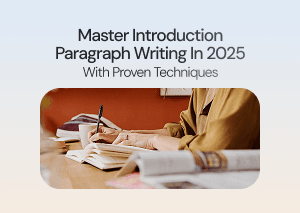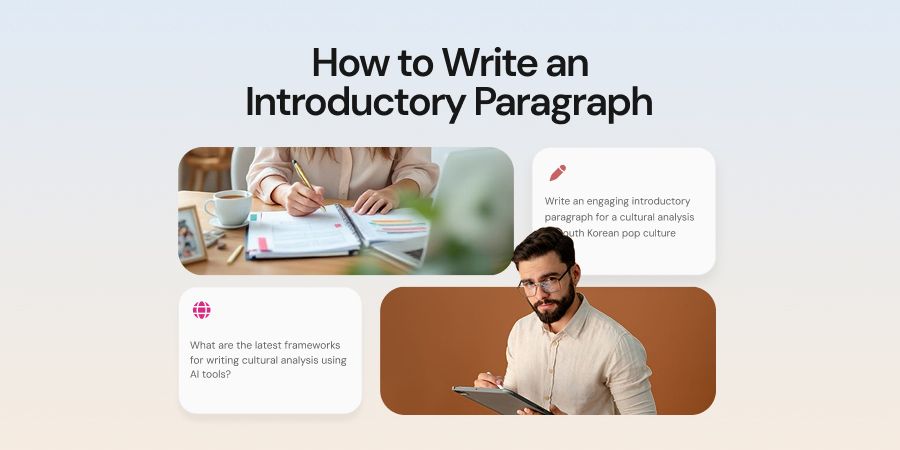
How to Write an Introductory Paragraph: Complete Guide with Examples
A good introduction paragraph tells the reader three things without them having to think about it: why they should care, what’s coming next, and how you’ll get them there. That applies whether you’re writing an essay introduction, a blog post intro, or the opening to a formal business report.
In essays, articles, and even professional reports, the introduction paragraph shapes the first impression. A strong opening signals authority, clarity, and intent; a weak one risks losing attention before the main ideas even begin.
An introduction paragraph is not just filler at the top of your work. It’s the foundation of the conversation you’re about to have with your reader.
Over the next sections, you’ll learn:
- Understand what an introduction is and why it matters
- Learn the structure that makes an introduction paragraph effective
- Identify and avoid common mistakes in introduction writing
- Explore multiple introduction paragraph examples for different contexts
- Master the process for writing a strong introduction paragraph in any style with confidence
What Is an Introduction Paragraph?
An introduction paragraph is the opening section of a piece of writing, designed to prepare the reader for what follows. It sets the context, establishes the tone, and often delivers the thesis or main idea.
In academic work, this paragraph explains the purpose of the paper and guides the reader toward the arguments or analysis that will follow. In blog writing, it hooks the reader and previews the value they’ll get from reading on.
Think of it as the handshake at the start of a meeting. In a few sentences, you communicate your intentions, make a connection, and lay the groundwork for what’s coming. Done well, it’s seamless. Done poorly, it’s awkward and forgettable.
There are differences between an intro paragraph for an essay and one for other formats. An essay introduction often needs to meet certain academic standards: present background information, state a thesis, and outline what the essay will cover. In contrast, a blog or marketing piece may prioritize attention-grabbing hooks and emotional resonance over formal structure.
- Clarity — The reader understands the topic right away.
- Relevance — It connects with the reader’s needs or curiosity.
- Direction — It signals where the piece is heading.
Writers sometimes confuse the introduction paragraph with a generic opening sentence. While an introduction sentence is important, it’s only one part of the paragraph.
The full introduction is a short but complete unit – an introductory paragraph – that combines the opening hook, necessary background, and a clear lead-in to the body.
You’ll encounter different introduction paragraph formats depending on context. For instance:
- Academic format: Hook → Background → Thesis statement.
- Online content format: Hook → Value proposition → Reader takeaway.
- Report format: Objective → Context → Method or scope.
Understanding what an introduction is and how it functions is the first step toward mastering it. In the sections that follow, we’ll explore why the introduction matters so much, the structure that makes it work, and how you can adapt it to any form of writing without losing its effectiveness.
Purpose of an Introduction
The purpose of an introduction paragraph is often underestimated. Many writers see it only as a starting point, but in reality, it serves as a strategic anchor for the entire piece. If you understand why introductions exist, you can design them to pull the reader in and set the tone for everything that follows.
The first job of an introduction is to capture attention. Whether it’s a blog, an academic essay, or a company report, the opening lines have to persuade the reader that what you’ve written is worth their time. Without that initial pull, even the strongest arguments in the body can go unread.
The second purpose is to establish context. Readers rarely arrive with the same level of knowledge you have about your topic. A good introduction paragraph gives them just enough background to understand the subject and see why it matters. This doesn’t mean overwhelming them with history or technical details. It means offering the right amount of information so they’re equipped to follow your points.
The third and final purpose is to set direction. An introduction acts like a roadmap. It tells the reader where the piece is going and what they can expect, whether it’s an academic thesis, a narrative journey, or a practical how-to guide. This is where a thesis statement or main claim often appears, making it clear what the central argument or theme will be.
In short:
- It hooks the reader’s attention.
- It frames the topic with the right amount of background.
- It signals the path ahead.
Whether you’re figuring out how to introduce a topic in a school essay, preparing the opening of a presentation, or starting a blog post, keeping these three functions in mind will make your introduction not just a paragraph, but a deliberate piece of persuasion.
Core Elements of a Strong Introduction Paragraph
Every good introduction paragraph contains certain components that work together to guide and engage the reader. The exact arrangement can vary depending on the introduction paragraph format, but the building blocks remain the same.
1. The Hook
The hook is your opening move, the introduction sentence that stops the scroll, interrupts the skim, and makes someone want to keep reading. There are several proven types:
- Statistical hooks: Using a surprising or impactful data point.
- Anecdotal hooks: Opening with a short, relatable story.
- Provocative question hooks: Asking a question the reader can’t ignore.
- Quotations: Starting with a quote that frames your point.
- Shocking fact hooks: Presenting something unexpected to spark curiosity.
For example, if you’re writing about environmental issues, you might begin:
"Every year, eight million tons of plastic enter our oceans. This is more than enough to cover every coastline in the world."
This statistic doesn’t just inform; it provokes concern and interest.
2. Background Information
Once you have the reader’s attention, you need to provide context. This section answers the question, “Why am I reading this?” In an introductory paragraph, background should:
- Define any essential terms.
- Set up the problem, question, or situation.
- Avoid overloading the reader with unnecessary details.
Background is especially important when learning how to write an essay introduction because it ensures the audience has the necessary framework before encountering the thesis.
3. The Thesis Statement
The thesis is the heart of the introduction paragraph structure. It’s a single sentence that distills your main point or argument. A strong thesis:
- States a clear position.
- Signals the direction of the piece.
- Matches the scope of the work.
For example:
"Urban gardening is more than a hobby; it’s a necessary step toward food security in modern cities."
This tells the reader exactly what the piece will explore and why.
4. The Transition
Finally, a strong introduction leads naturally into the main content. This transition can be a single sentence or a short bridge that connects the intro paragraph to the first body section. Without it, the shift can feel abrupt and leave the reader disoriented.
A well-built introduction blends these elements so they feel seamless. You might start with a question hook, add a sentence of background, follow with your thesis, and then glide into the body. The key is making sure each element is present and doing its job.
In the next section, we’ll explore types of introduction paragraphs you can use, along with introduction examples to help you choose the right approach for your writing style and audience.
Types of Introduction Paragraphs
Not every introductory paragraph needs to follow the same mold. The structure, tone, and hook you choose should match your audience, purpose, and medium. Below are the most common types of introduction paragraphs, along with examples and advice on when to use each.
1. Narrative Introduction
A narrative introduction tells a short, vivid story to draw readers into the topic. It works especially well when you want to build a personal connection or create emotional impact.
When to use:
- Personal essays
- Speeches
- Creative nonfiction
- Blog posts with a human angle
Example of introduction:
"When I first stepped into the crowded market of Marrakech, the air was thick with the scent of spices, and the hum of bargaining voices filled every corner. I didn’t know then that I would leave with more than souvenirs. Now, I leave with a new understanding of cultural exchange."
This style hooks the reader with imagery and atmosphere before revealing the main theme.
2. Question-Based Introduction
This approach starts with a question that makes readers think and encourages them to keep reading for the answer. A question hook can be direct or rhetorical, but it must feel relevant.
When to use:
- Opinion pieces
- Educational articles
- Persuasive essays
Example of introduction paragraph:
"What would happen if every smartphone in the world stopped working tomorrow? Would we adapt, or would society grind to a halt?"
The key here is posing a question that aligns with your topic and sparks curiosity.
3. Quotation-Based Introduction
A carefully chosen quotation can frame your topic, lend credibility, or provide a thought-provoking starting point. Just make sure the quote directly connects to your thesis.
When to use:
- Academic essays
- Analytical writing
- Literature reviews
Introduction paragraph example:
"As George Orwell once wrote, ‘In a time of deceit, telling the truth is a revolutionary act.’ This idea is at the heart of journalism ethics and the fight against misinformation today."
Quotations should be attributed and smoothly integrated into your opening lines.
4. Statistical or Data-Driven Introduction
Numbers have power. A striking statistic or fact in your introduction sentence can stop readers in their tracks and set a logical, evidence-based tone.
When to use:
- Research papers
- Reports
- Informative articles
Good introduction example:
"Every day, the average office worker receives 121 emails. That’s more than 600 every workweek and most never get read."
The reader instantly sees the relevance and scale of the issue.
5. Shocking Fact Introduction
This style relies on surprising, even unsettling, information to jolt the reader into paying attention. It overlaps with statistical openings but can also be non-numerical.
When to use:
- Advocacy writing
- Awareness campaigns
- Topics with urgency
Example of introductory paragraph:
"There are more vacant houses in the United States than there are homeless people. Yet every night, over half a million Americans sleep without shelter."
The aim is to provoke both interest and emotion, setting the tone for a strong argument.
6. Compare-and-Contrast Introduction
By highlighting two opposing ideas or scenarios, you can set up a tension that your piece will resolve. This creates an immediate sense of conflict and curiosity.
When to use:
- Analytical essays
- Opinion columns
- Historical comparisons
Intro paragraph format example:
"A century ago, letters took weeks to cross oceans. Today, a message can circle the globe in seconds and yet miscommunication is more common than ever."
This opening signals that the piece will explore the causes and implications of that contrast.
7. Contextual or Background Introduction
Sometimes, the most effective start is to ground the reader in the facts or history they need to understand your argument. This approach is common in introduction essays and formal writing.
When to use:
- Research essays
- Historical analysis
- Reports
Example of introduction:
"In 2015, the Paris Agreement was signed by nearly every country on Earth, marking a global commitment to combat climate change. Yet, years later, the path to its goals remains uncertain."
This introduction leads with context, priming the reader for deeper analysis.
8. Hybrid Introduction
Many professional writers blend elements from different types. For example, starting with a statistic and then moving into a short anecdote. A hybrid approach lets you tailor the introduction to the complexity of your topic.
When to use:
- Long-form articles
- Thought leadership pieces
- In-depth reports
Good introduction paragraph example:
"Last year, cybercrime cost businesses more than $8 trillion globally. For a small design agency in Toronto, one phishing email was enough to erase a decade of work, and they’re not alone."
It combines a data point with a real-world narrative, hitting both logical and emotional notes.
Why this matters:
Knowing these types of introduction paragraphs gives you a toolkit. When you sit down to write, you can choose the format that best matches your purpose, audience, and subject. This also makes it easier to vary your style, so your writing never feels repetitive.
How to Write an Introduction Paragraph Step-by-Step
Even the most experienced writers can feel stuck when staring at a blank page.
Knowing how to write an introduction paragraph is about following a logical sequence that ensures the paragraph does its job every time. Here’s a step-by-step process you can use for any format, from essay introductions to blog intros and reports.
Step 1: Define Your Audience and Purpose
Before writing a single word, clarify who you’re writing for and what you want them to take away. An introduction paragraph that works for a college research paper won’t be the same as one written for a product launch post.
Ask yourself:
- Who will read this?
- What tone do they expect?
- What action or thought do I want them to have after reading?
Knowing your audience will shape the tone, the choice of hook, and the introduction paragraph format you use.
Step 2: Choose the Right Type of Introduction
From narrative openings to statistical hooks, the choice should serve both your topic and your audience. If you’re writing a policy report, a shocking fact introduction might work better than a casual anecdote. If you’re writing for a lifestyle blog, a narrative introduction might feel more engaging.
This choice determines the introductory paragraph structure and sets expectations for the rest of the piece.
Step 3: Craft Your Hook
The hook is your opening move, your introduction sentence. Its sole purpose is to grab attention.
Techniques include:
- Startling statistics
- Thought-provoking questions
- Short, vivid anecdotes
- Relevant quotations
- Striking contrasts
Example:
"What if your morning coffee could predict the weather? It sounds absurd, but the science of data analysis is making it possible."
This makes readers curious without revealing too much.
Step 4: Provide Background Without Overloading
Once you’ve hooked the reader, offer enough background to set the stage. This might mean defining a term, summarizing a situation, or giving a brief historical context. The trick is balance, too little context leaves readers confused, too much makes them lose interest.
For example, if your essay is about renewable energy, you might briefly explain the current global energy mix and its environmental impact before moving to your thesis.
Step 5: Write a Clear Thesis Statement
Your thesis is the core of your intro paragraph. It’s usually one sentence, placed near the end of the introduction, that tells readers your main point.
A good thesis:
- Is specific, not vague
- Matches the scope of your piece
- Signals the direction of your argument or analysis
Example:
"Renewable energy is not just an environmental choice; it is the most economically viable option for global power generation over the next decade."
This sets up the reader’s expectations for what the body will prove.
Step 6: Add a Smooth Transition
An introductory paragraph should never end abruptly. Add a sentence that naturally leads the reader into the first section of the body. This could hint at the main points you’ll cover or pose a question the next paragraph will answer.
Example:
"Understanding the barriers to renewable adoption requires looking at policy, technology, and public perception and how they can align for change."
Step 7: Review and Refine
When you’ve written your draft, step back and read the introduction aloud. Look for:
- Flow between sentences
- Overly complex wording
- Gaps in context
- Hooks that feel weak or forced
If you’ve already written the body of the piece, you may find you need to adjust the intro so it matches the content. Many writers refine their introduction paragraph last to ensure perfect alignment.
Following these steps makes the process less intimidating and ensures your introduction fulfills all three core purposes: hook the reader, set the context, and guide them into the content.
How to Start an Introduction Paragraph
The opening sentence of your introduction paragraph is the handshake, the tone-setter, and the moment you either win or lose the reader’s attention. Whether it’s an essay introduction, a formal report, or a blog post, the start determines whether your audience stays engaged.
To master how to start an introduction paragraph, choose an opening that matches your audience, subject, and purpose. Here are six proven methods, explained in detail with good introduction examples you can adapt.
1. Use a Striking Fact or Statistic
Facts and numbers grab attention by grounding the reader in reality. A surprising or relevant figure disrupts expectations and encourages curiosity.
Example:
"Over 40% of global food is wasted before it reaches a plate. This amount is enough to feed three billion people each year."
Why it works:
- Creates urgency.
- Establishes credibility.
- Appeals to logic and reason.
Best for:
- Research papers
- Policy briefs
- Data-focused reports
Tip: Always use credible, directly relevant statistics.
2. Ask a Thought-Provoking and Relevant Question
Questions invite mental participation and make readers think. A well-crafted question should align with your topic and lead naturally into your main point.
Example:
"If time travel were possible, would you visit the past to change history, or the future to see what happens?"
Why it works:
- Engages curiosity.
- Encourages reflection.
- Opens the way to your thesis.
Best for:
- Opinion pieces
- Editorials
- Creative writing
Tip: Avoid simple yes/no questions unless they lead to a surprising angle.
3. Tell a Short and Vivid Story
A brief, sensory-rich anecdote appeals to emotion and makes the reader care before presenting your main point.
Example:
"The rain-soaked letter sat unopened on the kitchen table, carrying news that would change everything."
Why it works:
- Creates emotional investment.
- Sets tone and atmosphere instantly.
- Draws readers into the scene.
Best for:
- Personal essays
- Speeches
- Human-interest content
Tip: Keep it concise and connect it directly to your thesis.
4. Open with a Relevant and Powerful Quotation
A well-chosen quote lends authority, inspiration, or thematic framing. It should tie directly to your argument or core message.
Example:
"As Maya Angelou wrote, ‘You can’t use up creativity. The more you use, the more you have.’ This principle is at the heart of every successful innovation strategy."
Why it works:
- Leverages respected voices.
- Summarizes themes quickly.
- Works in academic and reflective contexts.
Best for:
- Analytical essays
- Motivational writing
- Leadership content
Tip: Avoid overused quotes; choose ones with fresh relevance.
5. Create a Clear and Relevant Contrast
Contrasting two ideas creates tension and invites exploration. This works when your topic involves change, evolution, or conflict.
Example:
"A century ago, letters took weeks to arrive. Today, a message can cross continents in a second yet miscommunication is more common than ever."
Why it works:
- Highlights differences.
- Sets up your argument.
- Creates instant intrigue.
Best for:
- Comparative essays
- Opinion columns
- Historical analysis
6. Make a Bold and Confident Statement
A strong, clear claim signals control over your subject and sets a persuasive tone.
Example:
"Remote work is the present, and companies ignoring it will fall behind."
Why it works:
- Commands attention.
- Signals authority.
- Clearly states your stance.
Best for:
- Persuasive writing
- Business thought leadership
- Articles challenging norms
Tip: Back it up with strong reasoning immediately in the body.
Why Your First Sentence Truly Matters
Your introduction sentence is the contract you make with the reader. It promises tone, depth, and relevance. A weak or generic start risks losing them before you present your main ideas. A strong one builds trust and primes them for your full introduction paragraph structure.
Done right, it ensures your audience reads on with focus and interest, making the rest of your intro paragraph far more effective.
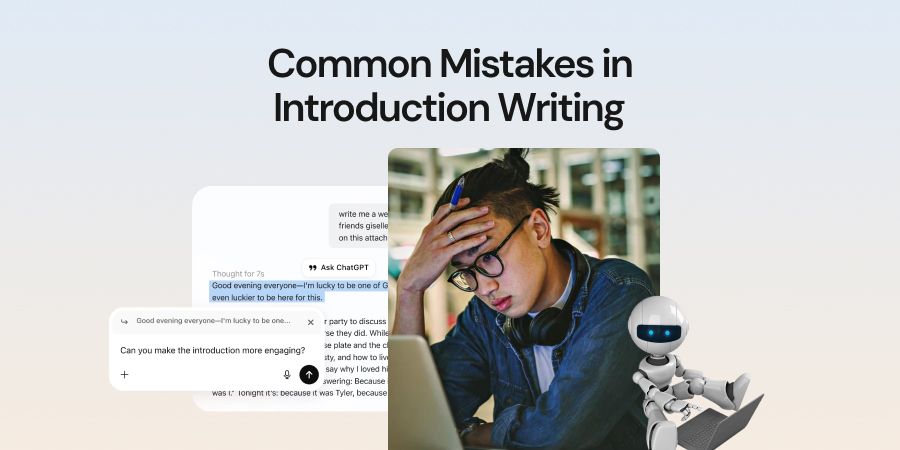
Common Mistakes in Introduction Paragraph Writing
Even strong writers can stumble when crafting an introduction paragraph. The opening feels deceptively simple, but a few missteps can weaken the entire piece. Knowing what to avoid is just as important as knowing what to include. Here are the most frequent mistakes and how to correct them.
1. Starting with a Generic Opening
A vague or overly familiar start fails to grab attention. Lines like "Since the dawn of time" or "In today’s world" sound tired and give the reader no reason to care.
Weak example:
"In today’s society, technology plays a big role."
Strong example:
"By the time you finish reading this sentence, over 50,000 Google searches will have been made worldwide."
Fix: Be specific, original, and immediately relevant to your topic.
2. Overloading with Excessive Background
Some writers pack their introductory paragraph with too much history or context, burying the point before the reader gets to it. This slows the pace and risks losing attention.
Weak example:
"In the early 1800s, industrialization began in Britain, spreading across Europe over decades and leading to social, political, and economic changes that we still see today in modern systems of production, trade, and labor."
Strong example:
"Industrialization transformed economies in the 19th century but its influence on modern labor practices is even more significant today."
Fix: Give just enough background to frame the discussion; save details for the body.
3. Hiding or Delaying the Thesis
Without a clear thesis in the introduction paragraph structure, the reader may not know what the piece is about. Burying it too far down creates confusion.
Weak example:
"Education has many benefits, and there are several things to consider when discussing it."
Strong example:
"Universal access to quality education is the single most powerful driver of economic growth in the 21st century."
Fix: Present your thesis or central claim near the end of the introduction so readers know your direction.
4. Using Clichés or Overused Phrases
Clichés make writing feel lazy and predictable. Expressions like "Needless to say", "At the end of the day", or "Ever since I was a child" add nothing fresh.
Weak example:
"Ever since I can remember, people have been talking about climate change."
Strong example:
"The last decade has been the hottest in recorded history, with climate change accelerating faster than scientists predicted."
Fix: Replace clichés with fresh phrasing that adds originality and precision.
5. Writing an Unbalanced Paragraph
An intro paragraph that is too short can feel rushed; one that is too long can overwhelm the reader. Both can make the start feel awkward.
Weak example (too short):
"This essay will discuss social media."
Weak example (too long):
A six-sentence ramble that covers every argument, statistic, and counterpoint before the reader even reaches the body.
Strong example:
"Social media has redefined how we connect, share, and consume information but its impact on mental health is only beginning to be understood."
Fix: Aim for a balanced paragraph: long enough to hook, set context, and state the thesis, but short enough to keep momentum.
6. Missing a Smooth Transition
Without a link between the introduction and the first body paragraph, the flow feels abrupt. The reader may feel the jump from opening to argument is jarring.
Weak example:
"Climate change is a global crisis. Now I will talk about renewable energy."
Strong example:
"Climate change is a global crisis and renewable energy offers one of the most practical solutions we can deploy today."
Fix: End the introduction with a sentence that naturally bridges to your first main point.
Key takeaway:
Avoiding these mistakes keeps your good introduction paragraph focused, engaging, and structurally sound. Each correction above shows how small changes can transform a flat opening into a compelling start that pulls readers deeper into your work.
Adapting Your Intro to Different Writing Styles
Not all introduction paragraphs are created equal. The way you start should reflect the purpose, tone, and expectations of the format you’re working in. Here’s how to adapt your approach for different types of writing without losing the fundamentals of a good introduction paragraph.
1. Craft a Formal Academic Essay Introduction
Academic writing demands structure, clarity, and authority. Your introductory paragraph should follow a predictable flow: hook, background, thesis. Avoid slang, casual phrasing, or unsupported claims.
Example:
"The rapid increase in antibiotic resistance presents a critical challenge to global health, threatening to undermine decades of medical progress."
Why it works:
- States the topic clearly.
- Establishes relevance.
- Positions the thesis as research-driven.
Tip: Cite credible sources early if needed to set authority.
2. Write an Engaging Blog Post Introduction
Blog audiences want value fast. A blog intro paragraph should mix an engaging hook with a clear promise of what’s inside the post. It can be conversational, even playful, depending on the brand voice.
Example:
"If you’ve ever abandoned a half-written to-do list because it felt impossible to finish, you’re not alone and today, you’ll learn a system that actually works."
Why it works:
- Speaks directly to the reader.
- Identifies a problem and offers a solution.
- Creates immediate relevance.
Tip: Keep it under 5–6 sentences to maintain momentum.
3. Shape a Persuasive Opinion Piece Introduction
An opinion piece needs to declare its stance quickly while still drawing the reader in. The introduction sentence should be bold, and the intro paragraph should outline the core argument without giving away all evidence.
Example:
"Banning plastic straws won’t save the oceans and believing it distracts us from the real threat."
Why it works:
- Grabs attention with a contrarian view.
- Signals the topic and position.
- Invites curiosity about the argument.
Tip: Make sure your claim is backed by strong reasoning in the body.
4. Develop a Professional Business Report Introduction
Business reports require clarity, precision, and immediate context. The introduction paragraph format here often includes the report’s purpose, scope, and key background points.
Example:
"This report examines quarterly sales performance, identifies the primary drivers behind revenue changes, and recommends strategies for improving client retention in Q3."
Why it works:
- Outlines scope immediately.
- Establishes professional tone.
- Prepares the reader for structured data.
Tip: Avoid unnecessary storytelling unless it directly supports the business context.
5. Build a Creative Writing Story Introduction
Creative openings lean heavily on mood, imagery, or character to immerse the reader immediately. The intro paragraph should invite the reader into the story world with sensory detail.
Example:
"The first snow of the season clung to the streets like powdered sugar, masking the cracks beneath."
Why it works:
- Sets a vivid scene.
- Creates atmosphere and tone.
- Sparks curiosity without overexplaining.
Tip: Ground the imagery in a way that hints at the story’s direction.
6. Prepare a Research Paper Introduction
A research paper intro balances formality with informative depth. It often includes the topic’s significance, the research gap, and the thesis or research question.
Example:
"Despite decades of climate modeling, urban heat islands remain under-researched in mid-size cities, leaving a critical gap in sustainable planning."
Why it works:
- Establishes problem and scope.
- Identifies a knowledge gap.
- Leads naturally into methodology.
Tip: Keep jargon minimal unless writing for a highly specialized audience.
Key takeaway:
Adapting your intro paragraph to its format ensures it meets audience expectations without losing impact. The structure remains like this: hook, background, thesis, but tone, pacing, and detail level change to match the medium.
Real-World Introduction Paragraph Examples
Theory gives you the rules; examples show you how those rules work in practice. Below are six good introduction paragraph samples taken from different types of writing. For each, we’ll look at why it works and what you can take away to improve your own intros.
1. Academic Essay Example
"The global demand for freshwater is projected to exceed supply by 40% in 2030, placing billions at risk of scarcity. This essay examines the key drivers of water stress and explores policy interventions that could prevent crisis-level shortages."
Why it works: Opens with a data-backed fact, establishes urgency, and presents a clear thesis without extra filler.
Writer’s takeaway: In academic contexts, lead with relevance and follow with a thesis that sets the reader’s expectations.
2. Blog Article Example
"Your morning coffee might be costing you more than you think, not in dollars, but in productivity. In this post, we’ll break down how your caffeine routine affects focus and share better ways to boost energy."
Why it works: Surprises the reader with a twist, speaks directly to them, and promises specific value.
Writer’s takeaway: Blog introductions should create curiosity and signal clear benefits in the same breath.
3. Opinion Column Example
"Banning gas stoves won’t solve our climate crisis and pretending it will distracts from the real battle we need to fight."
Why it works: Comes out swinging with a strong, contrarian claim that instantly signals perspective.
Writer’s takeaway: Opinion pieces benefit from decisive, confident openings that establish the stance immediately.
4. Business Report Example
"This report reviews Q2 sales results, analyzes performance by region, and identifies growth opportunities for the second half of the fiscal year."
Why it works: States purpose, scope, and focus in a single, uncluttered sentence.
Writer’s takeaway: In professional contexts, skip the warm-up, clarity and directness build trust.
5. Creative Story Example
"The first scream echoed through the empty halls, bouncing off marble walls and fading into the cold night air."
Why it works: Uses sensory imagery to set mood and tension without explaining too much.
Writer’s takeaway: Creative openings thrive on atmosphere; pull readers in through feeling rather than facts.
6. Research Paper Example
"Despite decades of public health campaigns, childhood obesity rates continue to rise, particularly in low-income urban communities. This study investigates the socioeconomic and environmental factors contributing to this trend."
Why it works: Presents the problem, signals importance, and introduces the research focus with precision.
Writer’s takeaway: Research intros should make the problem and scope clear in the very first sentences.
Closing insight:
Across formats, the structure of a strong introduction paragraph doesn’t change much, hook the reader, provide essential context, and lay out the direction. What changes is the balance of formality, emotional pull, and detail.
Conclusion – Mastering the Introduction Paragraph
The introduction paragraph is more than just the first part of your writing. It’s the moment you establish trust, set expectations, and persuade the reader to invest their time. Whether you’re crafting an academic essay introduction, a business report opening, or a narrative hook, the same core principles apply: grab attention, provide essential context, and guide the reader toward your main idea.
We’ve explored the structure, formats, examples, and mistakes to avoid and now, it’s about practice. Every time you write, treat your intro as the gateway to the rest of your work. Make it purposeful. Make it clear. And most importantly, make it worth reading.
Frequently Asked Questions
Straightforward answers to common questions on writing impactful and well-structured introductory paragraphs.
More topics you may like
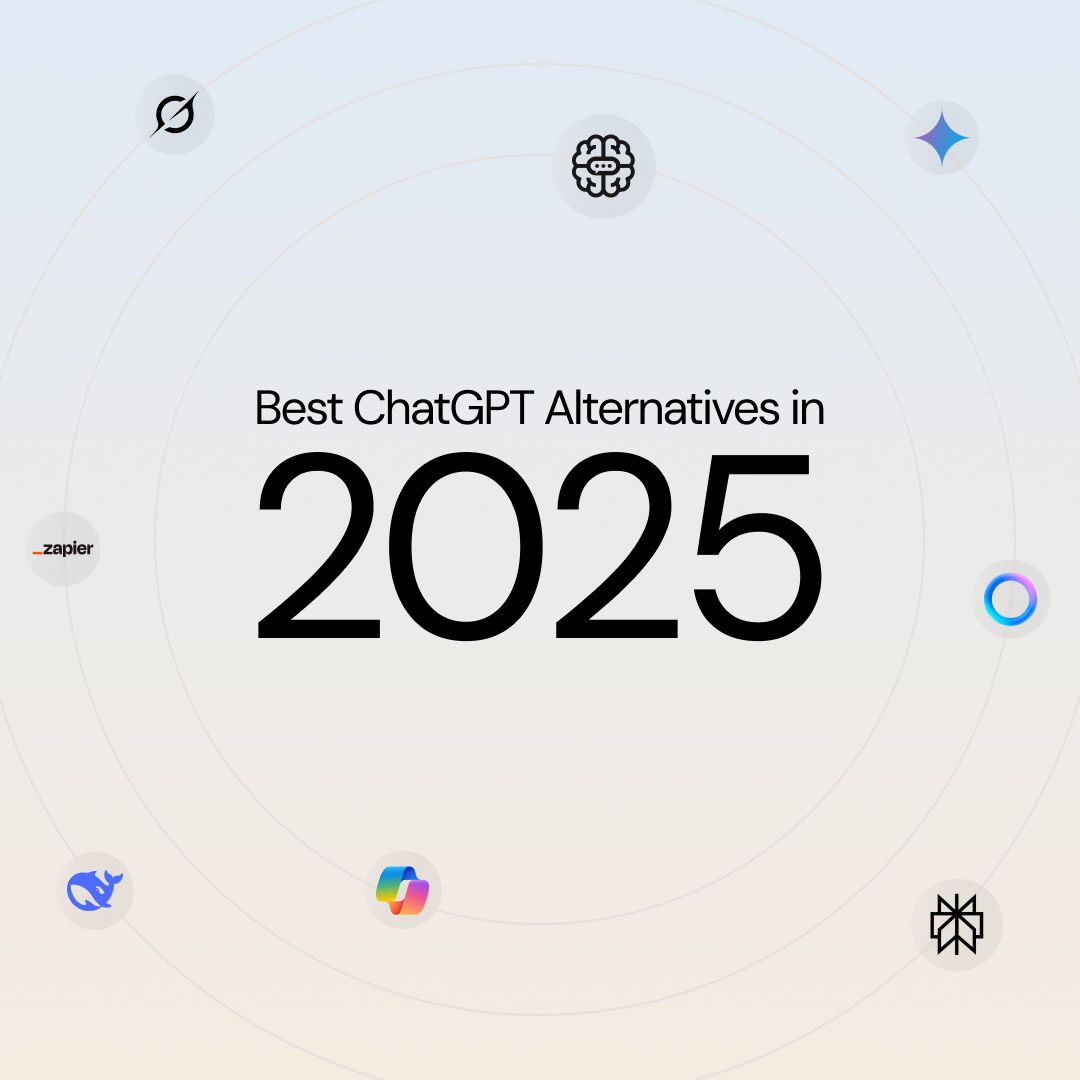
11 Best ChatGPT Alternatives (Free & Paid) to Try in 2025 – Compare Top AI Chat Tools

Muhammad Bin Habib
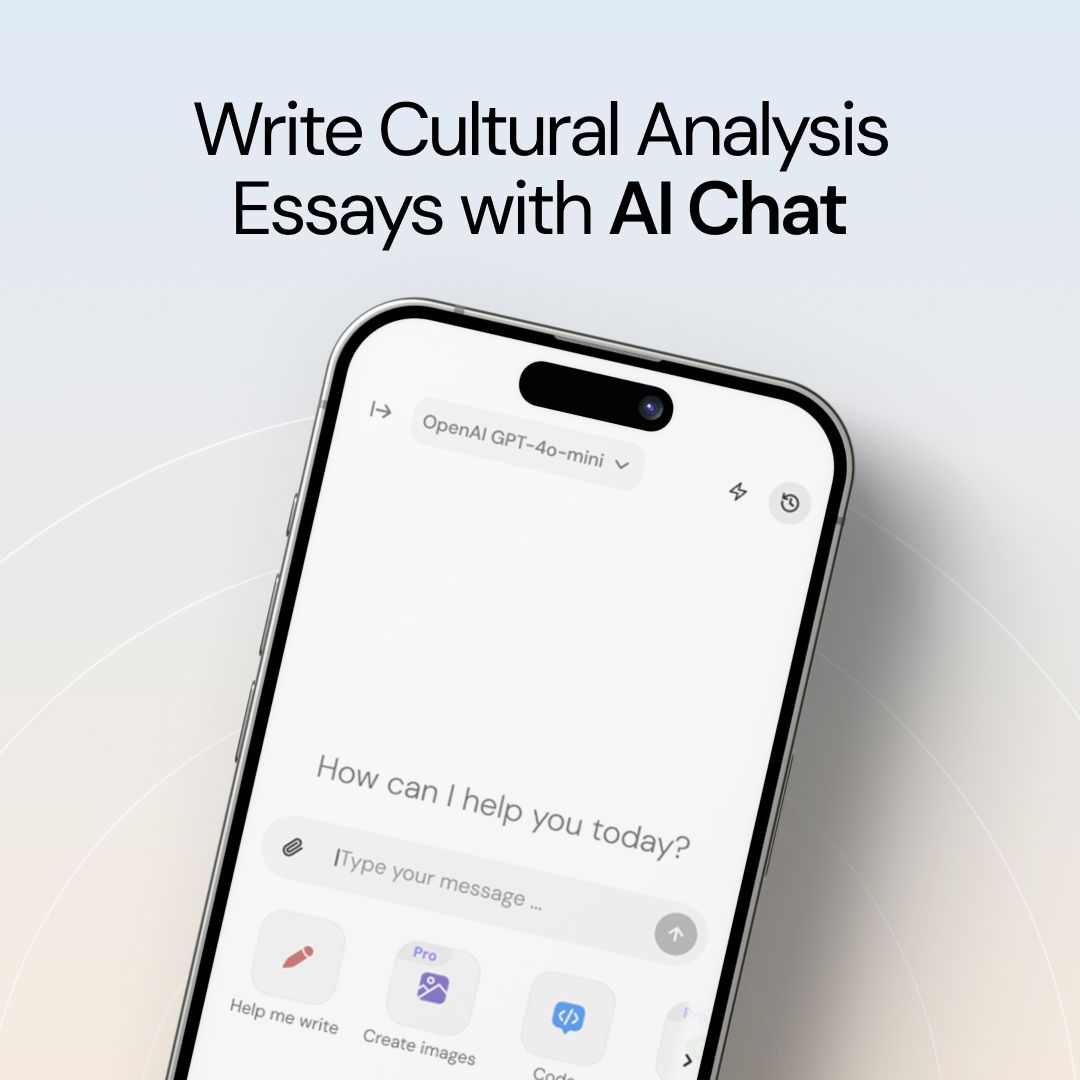
How to Write Cultural Analysis Essays Using AI Chat

Faisal Saeed
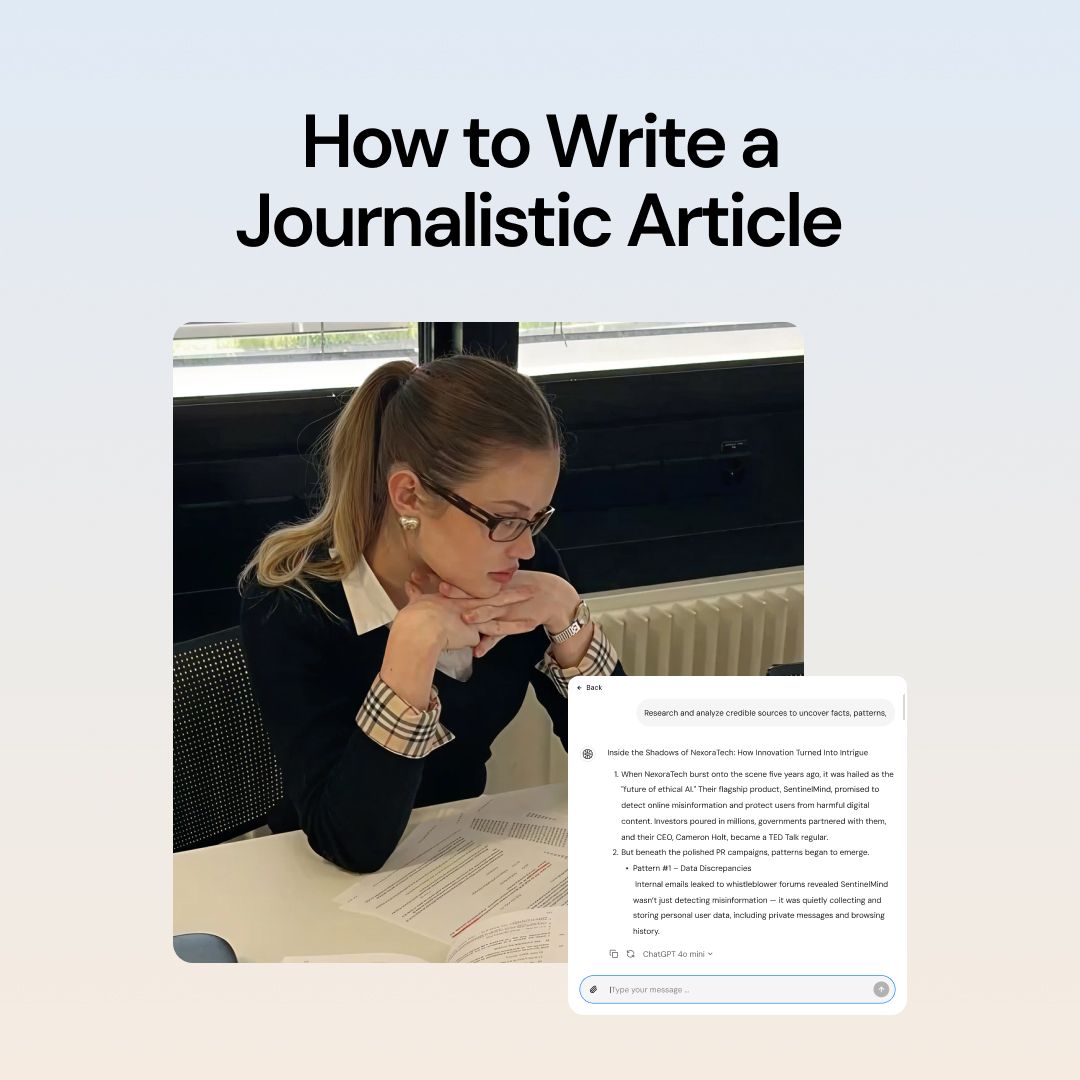
How to Write a Journalistic Article: Definition, Types, Structure and More

Muhammad Bin Habib

How to Write a Cover Letter with No Experience Using AI Chat

Muhammad Bin Habib
